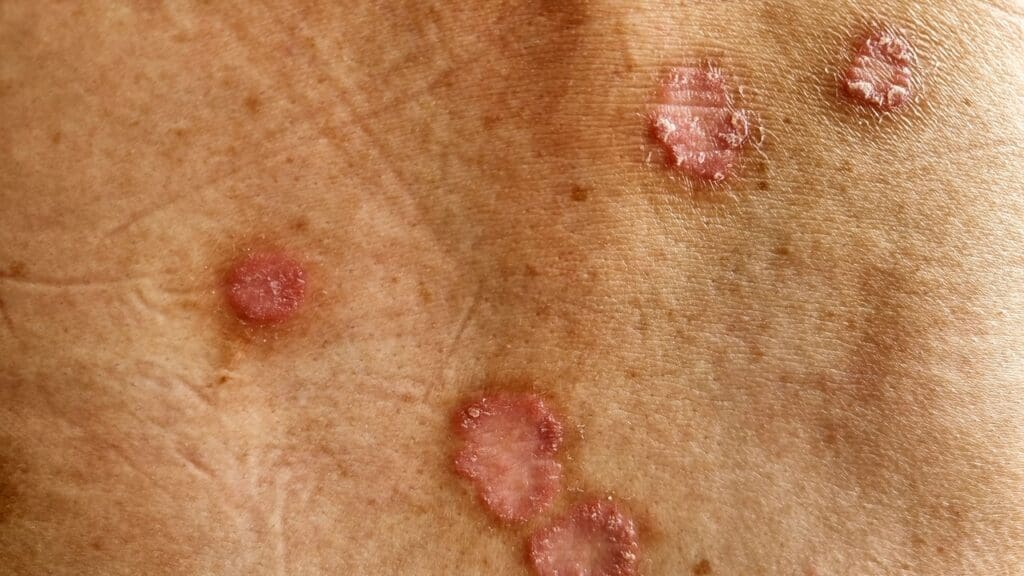Last Updated on November 27, 2025 by Bilal Hasdemir

Untreated skin cancer poses severe health risks, from permanent disfigurement to potentially fatal outcomes. The American Academy of Dermatology says skin cancer is the most common type of cancer worldwide. Over 9,500 people are diagnosed every day in the United States alone.
Basal cell carcinoma, if left untreated, can cause ulcers and damage tissues. Squamous cell carcinoma can spread to lymph nodes and organs, becoming life-threatening. Melanoma, though less common, is very aggressive and causes most skin cancer deaths.
At Liv Hospital, we stress the need for early detection and treatment to avoid severe consequences. Delaying care can be deadly, with up to 75% of skin cancer deaths from melanoma when treatment is delayed.
Key Takeaways
- Untreated skin cancer can lead to severe disfigurement and potentially fatal outcomes.
- Basal cell carcinoma can cause ulceration and extensive tissue damage if left untreated.
- Squamous cell carcinoma can metastasize to lymph nodes and organs, becoming life-threatening.
- Melanoma is highly aggressive and responsible for most skin cancer deaths.
- Early detection and treatment are critical to preventing devastating consequences.
Understanding Skin Cancer: Types and Prevalence
We must understand the different types of skin cancer to know its overall impact and risks. Skin cancer is not just one disease but a group of conditions. The main types are basal cell carcinoma, squamous cell carcinoma, and melanoma.
Common Types of Skin Cancer
Basal cell carcinoma is the most common, making up about 80% of cases. It grows slowly and rarely spreads. Squamous cell carcinoma is the second most common and can spread more easily. Melanoma, though less common, is the most aggressive and can be deadly if caught late.
Skin Cancer Statistics in the United States
The American Academy of Dermatology shares important statistics on skin cancer in the U.S. They say over 9,500 people get diagnosed with skin cancer every day. This means about 3.5 million cases happen each year, with basal cell and squamous cell carcinomas leading the way.
Risk Factors for Developing Skin Cancer
Many factors increase the risk of skin cancer. These include being exposed to UV radiation from the sun or tanning beds, having fair skin, a history of sunburns, and a family history of skin cancer. Knowing these risk factors helps in preventing and catching skin cancer early.
The Importance of Early Detection and Treatment
Early detection is key to treating skin cancer successfully. When caught early, treatments work better, and recovery chances improve. It’s vital to know the warning signs, understand how to screen, and know the high cure rates with early action.
Warning Signs and Symptoms to Watch For
Keep an eye on your skin for changes. Look out for new or changing moles, sores that won’t heal, and red, scaly, or bleeding patches. Regular skin checks and seeing a dermatologist for unusual spots are important.
- Asymmetry: Moles that are irregular in shape.
- Border: Moles with uneven or notched edges.
- Color: Moles with multiple colors or uneven color distribution.
- Diameter: Moles that are larger than 6mm in diameter.
- Evolving: Changes in size, shape, or color over time.
Screening and Diagnostic Methods
Regular skin checks by a dermatologist are vital for early detection. During a skin examination, the dermatologist will assess your skin for any suspicious lesions or changes. If necessary, a biopsy may be performed to determine if a lesion is cancerous.
| Screening Method | Description | Benefits |
|---|---|---|
| Visual Examination | A dermatologist visually examines the skin for suspicious lesions. | Non-invasive, quick, and effective for identifying possible issues. |
| Biopsy | A sample of skin is taken for further examination. | Definitive diagnosis of skin cancer. |
| Dermoscopy | A specialized microscope used to examine skin lesions in detail. | Helps in identifying features of skin cancer that are not visible to the naked eye. |
High Cure Rates with Prompt Intervention
Early detection significantly improves cure rates for skin cancer. For example, melanoma has a much higher survival rate when caught early. Early action can prevent cancer from spreading, reducing risks and improving outcomes.
By being proactive about your skin health and getting regular check-ups, you can lower skin cancer risks. Early detection and treatment are key to managing skin cancer effectively.
What Happens If Skin Cancer Goes Untreated: An Overview
Leaving skin cancer untreated can have serious effects. It can harm a person’s quality of life and even their chance of survival. It’s important for patients to know how untreated skin cancer progresses.
Studies show that skin cancer grows at different rates. Melanoma, for example, is very aggressive. Skin cancer experts say early detection and treatment are key to better survival chances and simpler treatments.
General Progression Timeline of Untreated Skin Cancer
The time it takes for untreated skin cancer to progress varies. Basal cell carcinoma (BCC) grows slowly over years. Squamous cell carcinoma (SCC) grows faster, and melanoma can spread quickly, sometimes in just weeks or months.
Factors Affecting Progression Rate
Several things can affect how fast skin cancer grows. These include the type of cancer, the person’s immune system, and exposure to UV rays. People with weak immune systems are more likely to see rapid growth.
How Long Can Skin Cancer Go Untreated Before Becoming Dangerous
The danger time for untreated skin cancer varies. Melanoma can be life-threatening in months, while BCC might take years. It’s critical for people to get medical help if they think they have skin cancer.
Early detection is key to avoiding the bad effects of untreated skin cancer. We suggest regular skin checks and seeing a doctor right away if you notice anything unusual.
Risk #1: Local Tissue Destruction and Disfigurement
Untreated skin cancer can lead to damage and disfigurement. This is true for basal cell carcinoma, which can spread to nearby tissues.
How Skin Cancer Invades Surrounding Tissues
Skin cancer, like basal cell carcinoma, can grow into nearby tissues. This can harm nerves, blood vessels, and cartilage. It causes a lot of pain and discomfort.
Cosmetic and Functional Consequences
Skin cancer can cause big changes in how you look and feel. For example, basal cell carcinoma on the face can change your appearance. It can also make you feel sad or upset.
It can also affect how you move or do things. This depends on where and how big the tumor is.
Cases Requiring Reconstructive Surgery
Often, skin cancer damage needs surgery to fix. Surgery can make you look and feel better. It helps improve your life quality.
The surgery’s complexity depends on the damage. Early treatment is key to avoid these problems. It helps patients get better faster.
Risk #2: Metastasis to Lymph Nodes and Distant Organs
Untreated skin cancer can turn into a serious condition called metastasis. This happens when cancer cells spread from the original tumor. They travel through the blood or lymphatic system and form new tumors elsewhere in the body.
The Process of Cancer Spread
The metastasis process is complex. First, cancer cells invade nearby tissues and reach blood vessels or lymphatic channels. Then, they can move to lymph nodes or distant organs, creating new tumors. The spread depends on the cancer type and how aggressive it is.
Common Sites of Metastasis
Skin cancer can spread to different parts of the body. For melanoma, common places include the lungs, liver, brain, and bones. Lymph nodes are also common sites, mainly for squamous cell carcinoma and melanoma. Knowing these patterns helps doctors diagnose and treat metastatic disease.
Impact on Treatment Options and Prognosis
When skin cancer spreads to lymph nodes and distant organs, treatment gets harder. Metastatic disease often needs aggressive treatments like chemotherapy, targeted therapy, or immunotherapy. The outlook for patients with metastatic skin cancer depends on how far it has spread and how well treatments work. Catching it early is key to stopping metastasis and improving chances of recovery.
Risk #3: Increased Treatment Complexity and Reduced Success Rates
When skin cancer is left untreated, treatment becomes much harder. This makes success rates go down. The disease gets worse, and simple treatments turn into complex surgeries.
How Treatment Options Change with Disease Progression
At first, skin cancer can be treated easily with small cuts or creams. But as it grows, treatments get more complicated. You might need bigger surgeries, radiation therapy, or medicines that affect your whole body. This makes treatment harder and less effective.
Impact on Survival Rates
Not treating skin cancer early makes it harder to cure. Studies show that waiting too long can lead to worse outcomes. The cancer becomes more aggressive and harder to control.
The Cost of Delayed Intervention
Waiting to treat skin cancer costs more. You need more complex and long treatments. This includes medical costs, lost work time, and a lower quality of life.
We stress the importance of acting fast to treat skin cancer. Early action improves treatment success and lowers costs. By knowing the risks of waiting, patients can make better choices. This can save lives and improve life quality.
Risk #4: Specific Dangers of Untreated Basal Cell Carcinoma
Basal cell carcinoma (BCC) is the most common skin cancer. It’s usually not life-threatening. But, ignoring treatment can cause serious health problems.
Tissue Damage and Ulceration Patterns
Untreated BCC can spread to nearby tissues. This can cause ulcers, leading to pain and discomfort.
Risk of Facial Disfigurement
Most BCCs happen on the face. If not treated, they can cause serious facial damage. This can affect both looks and function.
Long-term Consequences of Neglected BCC
Ignoring BCC can have long-lasting effects. You might need major surgery to fix damaged tissue. Sometimes, the cancer comes back, requiring more treatment.
| Consequence | Description | Potential Outcome |
|---|---|---|
| Tissue Damage | Invasion of surrounding tissues | Ulceration, pain, and discomfort |
| Facial Disfigurement | Destruction of facial tissue | Cosmetic and functional issues |
| Long-term Consequences | Need for extensive reconstructive surgery | Recurrence of cancer, ongoing treatment |
In conclusion, untreated basal cell carcinoma is risky. It can cause tissue damage, facial disfigurement, and long-term health issues. Getting treatment quickly is key to avoiding these problems.
Risk #5: Consequences of Untreated Squamous Cell Carcinoma
Squamous cell carcinoma can cause serious problems if not treated quickly. We will look at what happens when this common skin cancer is ignored.
Increased Risk of Metastasis Over Time
Untreated squamous cell carcinoma can spread to other parts of the body. This makes treatment harder and lowers the chance of survival. The risk of metastasis grows with time, so catching it early is key.
Morbidity and Mortality Statistics
Squamous cell carcinoma can lead to a lot of suffering and death if not treated. The numbers show it’s a serious issue. We need to think about these statistics when we talk about SCC risks.
- About 1 in 5 people with SCC will see it come back or spread.
- In the United States, SCC kills around 2-3% of people.
When SCC Becomes Life-Threatening
SCC can be deadly if it spreads or attacks important areas. Quick medical action is vital to stop this. We stress the importance of regular skin checks and early treatment to avoid these bad outcomes.
Knowing the dangers of untreated squamous cell carcinoma helps us see why catching it early is so important. This can lead to better results for patients.
Risk #6: The Aggressive Nature of Untreated Melanoma
Untreated melanoma is a big threat because it grows fast and can spread quickly. We will look at the dangers of not treating melanoma. This includes how fast it can grow, why it’s so deadly, and survival chances at different stages.
Rapid Progression Timeline
Melanoma can grow fast, sometimes in just weeks. If not treated quickly, it can be fatal. It can quickly spread to other parts of the body, making early treatment key.
Key factors influencing the rapid progression of melanoma include:
- The thickness of the tumor at diagnosis
- The presence of ulceration
- The rate of mitosis
Why Melanoma Causes 75% of Skin Cancer Deaths
Even though it’s not as common, melanoma is behind 75% of skin cancer deaths. Its aggressive nature and ability to spread early are the main reasons.
The high lethality of melanoma shows how important early detection and treatment are. Catching it early greatly increases survival chances. Regular skin checks and quick medical action are vital if you notice anything unusual.
Survival Rates at Different Stages
Survival rates for melanoma depend on when it’s found. For early-stage melanoma, the 5-year survival rate is about 99%. But, this rate drops a lot for more advanced stages.
| Stage at Diagnosis | 5-Year Survival Rate |
|---|---|
| Localized | 99% |
| Regional | 66% |
| Distant Metastasis | 27% |
In conclusion, melanoma’s aggressive nature stresses the need for early detection and treatment. Knowing the risks and acting early can improve survival chances and lower death rates from this aggressive skin cancer.
Risk #7: Is Skin Cancer Fatal? Understanding Mortality Risk
It’s key for both patients and doctors to know about skin cancer’s risk of death. Skin cancer is usually treatable if caught early. But, it can be deadly if not treated or diagnosed late.
Can Skin Cancer Be Deadly? The Statistics
Skin cancer can be deadly, with some types being more dangerous. Melanoma is the main cause of skin cancer deaths. In the U.S., over 9,500 people get skin cancer daily, with melanoma causing 75% of deaths.
Factors That Determine Lethality
Several things decide if skin cancer is deadly, including:
- The type of skin cancer: Melanoma is more deadly than BCC and SCC.
- Stage at diagnosis: Early-stage cancer is easier to treat than late-stage.
- Patient’s overall health: Existing health issues can impact treatment success.
Comparing Mortality Rates Among Different Skin Cancers
Mortality rates differ among skin cancer types. BCC rarely spreads and has low death rates. SCC can be aggressive. But, melanoma has the highest death rate because it grows fast and can spread far.
Knowing these risks helps us see why early detection and prevention are so important. They can lower the risk of death from skin cancer.
Conclusion: Taking Action Against Skin Cancer
It’s key to know the dangers of untreated skin cancer. We’ve looked at seven big risks, from damage to tissues to the chance of cancer spreading and being deadly.
To fight skin cancer, we need to prevent and treat it. Using sunscreen and wearing protective clothes helps a lot. Also, getting regular skin checks and seeing a doctor fast if you notice anything odd is vital.
If skin cancer is found early, treatment can make a big difference. We should always look after our skin and get medical help when we need it. This way, we can avoid serious problems and make treatments work better.
Can skin cancer be fatal? Yes, it can, but catching it early and treating it helps a lot. We must take skin cancer seriously and act fast to prevent and treat it. Knowing the risks of not treating cancer helps us understand why we need to act quickly.
FAQ
What happens if skin cancer is left untreated?
Untreated skin cancer can cause serious problems. It may lead to disfigurement, spread to other parts of the body, and even be fatal. The outcome depends on the type and stage of the cancer.
How long can skin cancer go untreated before it becomes dangerous?
The time it takes for skin cancer to become dangerous varies. Some types, like melanoma, can grow fast. Others, like basal cell carcinoma, may take years to cause harm.
What are the risk factors for developing skin cancer?
Several factors increase your risk of skin cancer. These include getting too much sun, having fair skin, a family history of skin cancer, and previous skin cancer. Knowing these risks helps you take steps to prevent it.
Can skin cancer be deadly?
Yes, skin cancer can be deadly. This is true, mainly for melanoma, which is the most dangerous type. Early detection and treatment are key to survival.
What are the warning signs and symptoms of skin cancer?
Look out for new or changing moles, sores that don’t heal, and unusual growths. Regular skin checks can catch these signs early.
How is skin cancer diagnosed?
Doctors use a visual check, biopsy, and other tests to diagnose skin cancer. Finding it early is important for effective treatment.
What are the treatment options for skin cancer?
Treatment depends on the type and stage of skin cancer. Options include surgery, radiation, chemotherapy, and immunotherapy.
Can basal cell carcinoma be left untreated?
No, basal cell carcinoma should not be left untreated. It can cause a lot of damage and disfigurement over time.
How does untreated squamous cell carcinoma progress?
Untreated squamous cell carcinoma can spread to lymph nodes and distant organs. This can lead to serious health problems.
What is the survival rate for melanoma at different stages?
Melanoma survival rates vary by stage. Early detection is key to improving survival chances.
Is skin cancer fatal if not treated promptly?
Yes, skin cancer can be fatal if not treated quickly. This is true for aggressive types like melanoma. Timely treatment is vital for better outcomes.
What are the consequences of delayed intervention for skin cancer?
Delayed treatment can make treatment harder and less effective. It also increases the risk of death.
How can I reduce my risk of developing skin cancer?
To lower your risk, protect your skin from the sun, do regular skin checks, and see a doctor if you notice any unusual changes.








